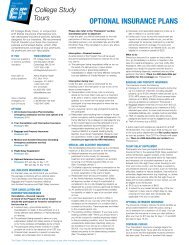View Merilyn's course syllabus (PDF) - EF College Study Tours
View Merilyn's course syllabus (PDF) - EF College Study Tours
View Merilyn's course syllabus (PDF) - EF College Study Tours
- No tags were found...
You also want an ePaper? Increase the reach of your titles
YUMPU automatically turns print PDFs into web optimized ePapers that Google loves.
the period, artistic or literary developments. Also noted<br />
should be points of intersection with biblical narratives<br />
(e.g. Joseph, Moses, Jeremiah’s exile, Jesus). The<br />
timeline is due on or before Mar. 15<br />
d. Select a topic of interest with respect to architecture,<br />
art, history, literature, or any other area of a specific<br />
period in ancient Egypt to research. The paper should<br />
be from four to six pages with a bibliography of works<br />
cited. The paper is due on or before April 15<br />
V. Textbooks<br />
Required:<br />
Ian Shaw, Ancient Egypt: A Very Short Introduction<br />
(Oxford University Press, 2004) ISBN-10: 0192854194 or<br />
ISBN-13: 978-0192854193<br />
John Currid, Egypt and the Old Testament (Baker Books,<br />
1997) ISBN 0-8010-2137-5<br />
John Romer, Ancient Lives: Daily Life in Egypt of the<br />
Pharaohs (New York: Henry Holt, 1984) ISBN 0-8-50-<br />
1244-3<br />
Recommended:<br />
Kathryn Bard, Introduction to the Archaeology of Ancient<br />
Egypt (Wiley, 2007) ISBN 10: 1405111488 or ISBN-13: 978-<br />
1405111485 (Brand new hardback but expensive; not yet<br />
available in paperback)<br />
Douglas Brewer and Emily Teeter, Egypt and the Egyptians<br />
(2nd ed., Cambridge, 2007) ISBN-10: 0521616891 or<br />
ISBN-13: 978-0521616898<br />
VI: Course Schedule<br />
The Egypt preview night will cover the introduction to the<br />
<strong>course</strong>, the <strong>syllabus</strong>, policies, and resources. If you have<br />
not had any previous <strong>course</strong>work in or formal exposure to<br />
archaeology, you will find it useful to browse any of Brian<br />
Fagan’s college textbooks on archaeology, particularly his<br />
In the Beginning.<br />
Day 1: Departure<br />
Before departure, look at and print the satellite map of<br />
Egypt so that you will be familiar with the topography of<br />
Egypt before you arrive. Download the map from uta.edu/<br />
anthropology/petruso/egypt05env.htm. Also become<br />
familiar with the sequence and dates of Egyptian periods<br />
of history from the handout.<br />
Day 2: Arrival in Cairo<br />
As we approach Cairo, look out the window and try to<br />
spot as many topographical features as you can from your<br />
map. Note what areas are densely populated and figure<br />
out what the reasons are for the distribution of people.<br />
Welcome to one of the most exotic capitals in the world.<br />
Transfer to the hotel.<br />
Day 3: Cairo<br />
We begin with the ultimate site, one of the Seven Wonders<br />
of the World, the Pyramids of Giza (Cheops, Khafre, and<br />
Menkaure). We will also visit the Sphinx and the entire<br />
funerary complex. Afterwards we will drive to Saqqara<br />
to see the oldest pyramid, the Step Pyramid of Djoser.<br />
Nearby Memphis was the capital of Egypt during the<br />
Old and Middle Kingdoms; it would have been here that<br />
Joseph managed the grain storage and distribution for the<br />
pharaoh. Happy New Year’s Eve!<br />
Day 4: Cairo<br />
Visit the Egyptian Museum and Old Cairo with its Coptic<br />
church and architecture. If possible we will visit the<br />
famous Ben Ezra Synagogue where the Cairo Geniza Old<br />
Testament manuscripts were found.<br />
Day 5: Aswan and Elephantine Island<br />
Fly to Aswan for the start of the Nile cruise. Tour the<br />
Aswan Dam, the Temple of Isis at Philae and the<br />
Unfinished Obelisk, once intended to be the largest<br />
structure of worked stone in the world. Take a delightful<br />
felucca (traditional Egyptian sailing boat) past Elephantine<br />
Island where the Elephantine Papyri and remains of a<br />
Jewish community were found.<br />
Day 6: Kom Ombo and Edfu<br />
Sail in a felucca to Kom Ombo to see the Temple of<br />
Sobek, the crocodile god. Then back on the boat to go<br />
to Edfu.<br />
Day 7: Esna<br />
We will visit the well-preserved Temple of Horus at Edfu<br />
before sailing on to Esna to visit the Temple on Khnum.<br />
Evening sail to Luxor.<br />
Day 8: Luxor and Karnak<br />
Today we visit the ancient city of Thebes with the huge<br />
complexes of temples at Luxor and Karnak. You may wish<br />
to attend the Sound and Light performance in the evening.<br />
Day 9: Valleys of the Kings and Queens<br />
The pharaohs of the New Kingdom were buried like the<br />
sun on the west bank of the Nile. We will see Valley of the<br />
Kings, going into one or more of the tombs before going<br />
on to the Valley of the Queens. The reading in Romer’s<br />
Daily Lives are based on the finds at Deir el-Medina, the<br />
village of the men and their families who worked on the<br />
tombs of the pharaohs, queens, and nobles. The tour of<br />
the funerary complex of Hatshepsut at Deir el-Bahri is<br />
important for her possible identification with the pharaoh’s<br />
daughter who adopted Moses. The Ramasseum with<br />
reliefs celebrating the Egyptians’ defeat of the Sea<br />
Peoples including the Philistines. A brief visit to the<br />
Colossus of Memnon will be our last before boarding the<br />
night train from Luxor to Cairo.<br />
Day 10: Cairo and the Egyptian Museum<br />
Arrive in Cairo and take a tour of the Citadel and the<br />
Egyptian Museum. There will be free time in the afternoon<br />
for shopping or people-watching.<br />
efcollegestudytours.com | 800-873-2250
















